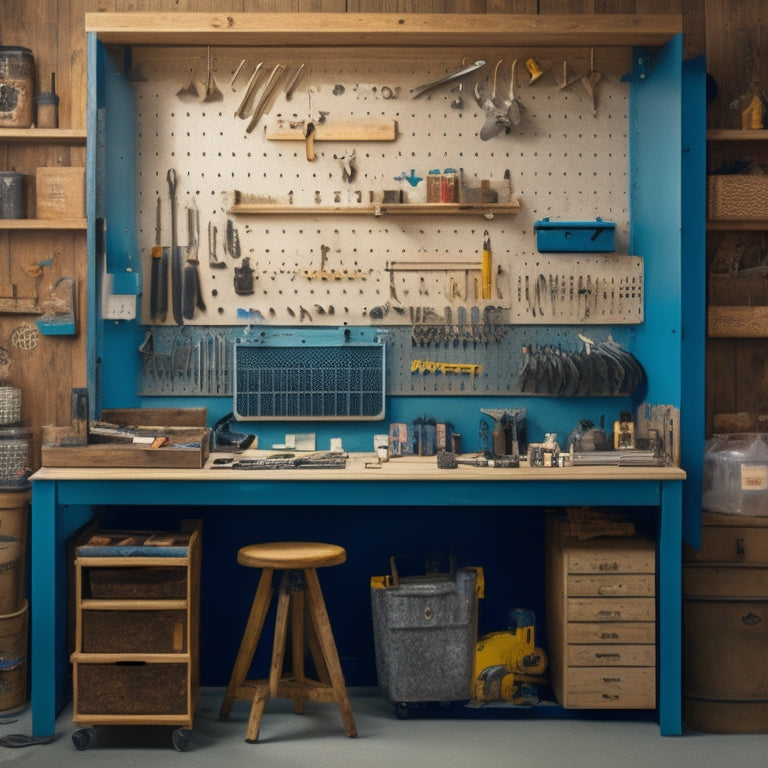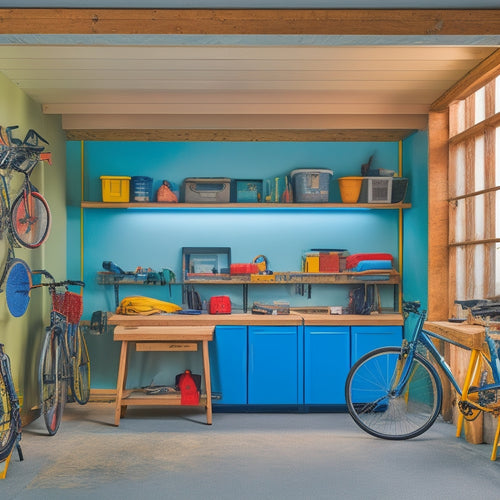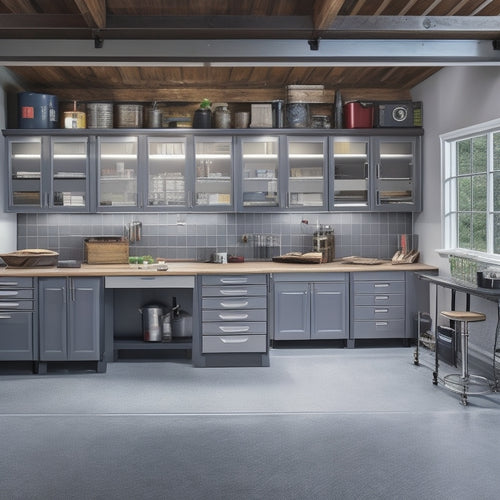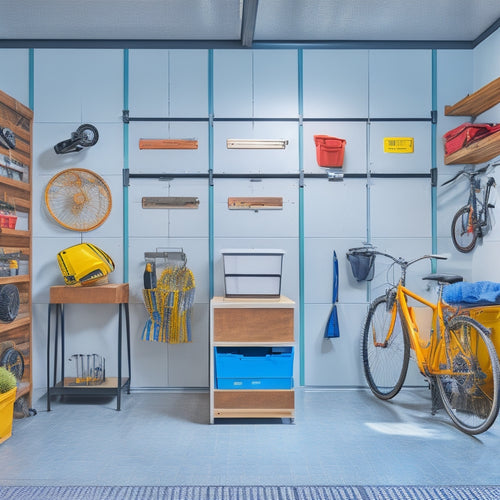
What Makes a DIY Workshop Truly Efficient?
Share
You create a truly efficient DIY workshop by systematically addressing six key areas. First, organize your tools and materials to maximize productivity. Streamline your workflow processes by optimizing task assignments and providing necessary resources. Next, design your workshop space to enhance productivity and reduce fatigue. Effectively manage your time by tracking task durations and scheduling tasks. Minimize distractions and clutter by designating specific areas for tasks and labeling storage units. Finally, prioritize tasks and goals by identifying critical tasks and allocating sufficient resources. By tackling these areas, you'll be well on your way to a seamless workflow - and there's still more to discover.
Key Takeaways
• A DIY workshop is truly efficient when tools and materials are organized, labeled, and stored logically to maximize productivity.
• Streamlining workflow processes by optimizing task assignments, providing necessary resources, and setting deadlines enables team members to work efficiently.
• An ergonomic and flexible workshop layout with sufficient lighting and minimal distractions enables DIYers to work comfortably and efficiently.
• Effective time management through time tracking, task batching, and time blocking helps DIYers complete tasks quickly and meet deadlines.
• Prioritizing tasks and goals by identifying critical tasks, breaking them down into smaller chunks, and allocating sufficient resources ensures efficient use of time and resources.
Organizing Tools and Materials
To maximize your workshop's productivity, categorize and store your tools and materials in a logical and accessible manner, grouping similar items together and keeping frequently used ones in easy reach. This will save you time and energy in the long run.
For instance, designate a specific area for tool maintenance, where you can clean, sharpen, and store your tools. Implement a regular routine to inspect and maintain your tools, ensuring they're in good working condition.
When it comes to material inventory, label and organize your materials by type, quantity, and project relevance. This will help you quickly identify what you have, what you need, and what you can reuse or repurpose. Keep a running tally of your materials, updating it after each project.
This will prevent you from overbuying or running out of essential materials mid-project. By maintaining a well-organized workshop, you'll be able to focus on what matters most - creating and serving others with your DIY skills.
Streamlining Workflow Processes
As you work to streamline your workflow processes, you'll want to start by optimizing task assignments to maximize your productivity.
This means identifying the tasks that require the most time and attention, and figuring out how to break them down into more manageable chunks.
Optimize Task Assignments
You can greatly enhance your DIY workshop's productivity by identifying the strengths and weaknesses of each team member and assigning tasks that leverage their individual skills. This is where task delegation comes into play, and it's crucial for team collaboration. By matching tasks with the right person, you'll observe a significant increase in efficiency and a decrease in frustration.
Here are some tips to help you optimize task assignments:
-
Clearly define tasks: Make sure each team member understands what's expected of them and what the end goal is.
-
Play to strengths: Assign tasks that align with each person's skills and expertise.
-
Provide necessary resources: Guarantee team members have the tools and training they need to complete their tasks successfully.
- Set deadlines and check-ins: Establish timelines and regular check-ins to keep everyone on track and motivated.
Simplify Tool Organization
By streamlining your tool organization, you'll reduce downtime spent searching for misplaced items and free up more time for actual project work, building on the productivity gains you've made by optimizing task assignments.
A well-organized workshop allows you to quickly locate the tools you need, saving you time and frustration.
Start by categorizing your tools into groups, such as hand tools, power tools, and specialty tools. Then, assign a designated storage spot for each group. Use tool labeling to identify what's inside containers or on pegboards, making it easy to find what you need at a glance.
Consider using clear storage bins or bins with dividers to keep small parts and accessories organized.
Implement a 'home' system, where each tool has a designated spot to return to after use. This encourages team members to put tools back in their place, maintaining a tidy workshop and preventing lost or misplaced items.
Efficient Use of Space
Now that you've streamlined your workflow processes, it's time to turn your attention to optimizing your workshop's physical space.
You'll want to assess your current layout and identify areas where you can improve traffic flow, reduce clutter, and make the most of every square foot.
Optimizing Workshop Layout
A well-planned workshop layout can greatly enhance your productivity by minimizing walking distances, reducing clutter, and increasing accessibility to essential tools and materials.
By optimizing your workshop layout, you'll be able to work more efficiently, safely, and effectively.
To achieve this, consider the following key elements:
- Ergonomic workstations: Design your workstations to fit your body and work style, reducing fatigue and discomfort.
- Efficient lighting: Guarantee sufficient lighting throughout the workshop, reducing eye strain and improving visibility.
- Flexible space design: Create a layout that can adapt to different projects and tasks, allowing you to easily reconfigure your workspace as needed.
- Workflow analysis: Study your workflow and identify areas where you can streamline processes, reducing waste and increasing productivity.
Streamlining Storage Solutions
Optimizing your workshop's storage capacity enables you to reclaim valuable floor space, reduce clutter, and quicken access to essential tools and materials. To achieve this, you'll want to implement a systematic approach to storage.
Start by installing vertical shelving to maximize your workshop's vertical space. Use labeled bins to categorize and store small items like screws, nuts, and bolts. This will help you find what you need quickly and prevent clutter from building up.
Consider investing in rolling storage units, such as carts or cabinets, to store larger items like power tools and equipment. These can be easily moved around the workshop as needed, freeing up floor space.
Don't forget to utilize your workshop's walls by installing hooks to hang items like bikes, helmets, or accessories. This will keep them organized and out of the way.
Effective Time Management
Your workshop's productivity hinges on your ability to allocate specific time slots for tasks, allowing you to tackle multiple projects simultaneously and meet deadlines. Effective time management is essential to getting the most out of your DIY workshop.
By implementing a few simple strategies, you can boost your efficiency and get more done in less time.
Here are some essential time management techniques to try:
-
Use time tracking to monitor how long tasks take, and identify areas for improvement
-
Implement task batching to group similar tasks together and complete them in one session
-
Employ time blocking to schedule specific tasks for specific times of the day or week
- Set realistic deadlines for yourself to stay focused and motivated
Minimizing Distractions and Clutter
By streamlining your workshop's organization and minimizing distractions, you'll be able to stay focused on the tasks at hand, building on the time management strategies you've already implemented.
A clear workspace is essential to achieving this goal. Start by designating specific areas for different tasks, such as a dedicated zone for painting or a designated spot for tool storage. This will help you quickly locate the tools and materials you need, reducing downtime and increasing productivity.
To create a distraction-free environment, consider the layout of your workshop. Position your workbench in a quiet area, away from high-traffic zones and noisy machinery. Install shelving and cabinets to keep clutter at bay, and label each storage unit so you can easily find what you need.
Make sure your workshop is well-lit, with good ventilation to prevent fatigue. By minimizing distractions and clutter, you'll be able to concentrate on the task at hand, completing projects efficiently and effectively.
With a clear workspace and distraction-free environment, you'll be well on your way to achieving a truly efficient DIY workshop.
Prioritizing Tasks and Goals
To maximize your workshop's efficiency, you must identify and prioritize the tasks and goals that will drive your projects forward, focusing on the most critical and time-sensitive ones first. Effective task prioritization and goal setting are essential to achieving your objectives and making the most of your time.
When setting goals, consider what needs to be accomplished and allocate your time and resources accordingly. Ask yourself: What're the most important tasks that need to be completed? What're the deadlines for each task? What resources do I need to allocate to each task?
Here are some key considerations for prioritizing tasks and goals:
- Identify the most critical tasks that will have the greatest impact on your project
- Break down large tasks into smaller, manageable chunks
- Set realistic deadlines and milestones for each task
- Allocate sufficient resources, including time, materials, and equipment, to complete each task
Implementing Productivity Systems
You've set clear goals and prioritized tasks, now it's time to implement systems that will help you stay on track and maintain momentum. An essential step in this process is implementing time tracking. This will allow you to identify areas where you can optimize your workflow, reducing wasted time and increasing productivity.
Additionally, task delegation is key to freeing up your time to focus on high-priority tasks. Identify tasks that can be delegated to others, and create a system for assigning and tracking these tasks.
Conduct a thorough workflow analysis to identify inefficiencies and areas for improvement. This will help you streamline your processes, eliminate bottlenecks, and create a more efficient workflow.
Utilize productivity tools such as project management software, calendars, and to-do lists to stay organized and on track. By implementing these systems, you'll be able to work more efficiently, freeing up time to focus on serving others.
Frequently Asked Questions
How Do I Deal With Procrastination in My DIY Workshop?
You tackle procrastination by prioritizing time management, finding motivation, and setting specific goals. Break tasks into smaller chunks, eliminating distractions, and create a schedule to stay on track, helping you achieve your DIY project objectives.
Can I Still Be Efficient With Limited Workshop Space and Budget?
You can still be efficient with limited workshop space and budget by optimizing your space with multi-functional tools and budget-friendly solutions, like repurposing materials and DIY storage hacks, to maximize productivity.
How Often Should I Clean and Maintain My DIY Workshop Tools?
As you wield your tools like a master chef's knives, remember to sharpen them regularly - schedule a weekly cleaning frenzy to maintain their edge, and organize your arsenal to guarantee every piece is within easy grasp.
What Safety Measures Should I Take in My DIY Workshop?
You prioritize safety in your DIY workshop by having a fire extinguisher and protective gear on hand, as well as a first aid kit and an emergency plan in place to respond quickly and effectively.
How Do I Balance DIY Projects With Other Aspects of My Life?
"You're not a superhero, but you're trying to be, juggling DIY projects with work, family, and social life! Prioritize tasks, schedule realistic deadlines, and master time management to achieve a harmonious work-life balance, or risk burning out!"
Related Posts
-

7 Essential Foldable Workbenches for Garages
When selecting a foldable workbench for your garage, you'll want to contemplate factors such as space-saving design, ...
-

Best Tool Chests for Home Garage Options
When selecting the best tool chest for your home garage, you'll want to evaluate top brands like DeWalt, Milwaukee, a...
-

3 Pro Garage Organization Ideas to Try Now
You can alter your garage from cluttered chaos to organized oasis with three pro garage organization ideas. First, op...


